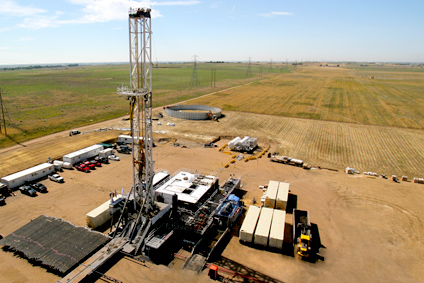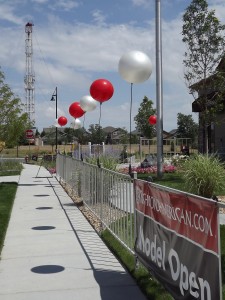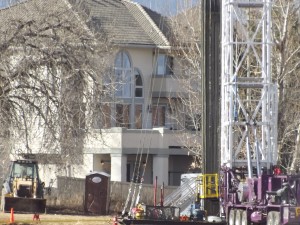What to Expect Before You Begin Drilling 500 Feet from a Group of Million Dollar Homes
Colorado’s Oil & Gas Task Force Offers Oil & Gas Operators, Local Homeowners Some Preliminary Solutions
Drilling the Niobrara was a check-the-box kind of routine for most of the oil companies operating in northern Colorado for the past 50 years. Secure the leases, file the forms, get your permits, pay your fees, follow the rules: voila – you’re drilling and completing wells, adding production, selling oil and natural gas liquids and booking reserves. But oil & gas operators have a new hurdle to leap: local homeowners.
 It has been pretty smooth going most of the time because the bulk of the Denver-Julesburg basin is sparsely populated. In rural Weld County, for example, the agricultural mineral owners who signed on the dotted line can see financial benefits coming and they welcome the influx of drill pads, rigs, trucks, pressure pumpers, and all the rest that goes along with drilling and producing oil and gas from shale layers 6,000 – 7,500 feet below their farms.
It has been pretty smooth going most of the time because the bulk of the Denver-Julesburg basin is sparsely populated. In rural Weld County, for example, the agricultural mineral owners who signed on the dotted line can see financial benefits coming and they welcome the influx of drill pads, rigs, trucks, pressure pumpers, and all the rest that goes along with drilling and producing oil and gas from shale layers 6,000 – 7,500 feet below their farms.
They are glad to allow construction of a couple of dirt access roads across their 3,000 acres of alfalfa, and they can put up with the extra dust, noise and truck traffic while the wells are drilled and completed. These are the farmers and landowners who leased the minerals to oil and gas companies and who look forward to their minerals being extracted and sold. Many of these landowners stand to see significant royalty payments hitting their bank accounts over the next 30 years.
 Not so for the neighboring homeowners living in developer-created neighborhoods next to drilling sites. Homeowners don’t own the rights to the minerals beneath their fancy new homes. Those rights were sold or leased long before today’s homeowner signed on the dotted line and took out a mortgage for his family’s half-million dollar home in Erie (Weld County) or his million-dollar residence in Lafayette (Boulder County).
Not so for the neighboring homeowners living in developer-created neighborhoods next to drilling sites. Homeowners don’t own the rights to the minerals beneath their fancy new homes. Those rights were sold or leased long before today’s homeowner signed on the dotted line and took out a mortgage for his family’s half-million dollar home in Erie (Weld County) or his million-dollar residence in Lafayette (Boulder County).
Once the notification of intent to drill is sent to mineral owners and surface owners, and all the other legal requirements are met, an operator can send the equipment to the drill site. In the case where a school or another multi-person structure is within a prescribed distance and has to be notified per Colorado statute, the driller complies by sending a letter to the address on file with the Colorado Dept. of Revenue, which might land in a school district file cabinet miles from the site. Or when notification goes to a property owner of a multifamily development, as required in the case of an apartment building located within close proximity to a drill site, the owner of record might be physically located four states away from the drill site.
Bottom Line: there is no requirement to inform nearby residents as to what’s coming (unless they happen to be the mineral rights owner or surface owner). No one is required to tell the families living in single family homes abutting the site that a dozen wells will be drilled and completed 500 – 1000 feet from their house.
Thus the neighbors receive nothing but noise, truck traffic, dust and some sleep deprivation if a 24-hour drilling operation starts up next door. All this activity is coupled with the public’s fear of the unknown: what are the chemicals used in frac fluid, how dangerous is the drilling and fracing process, how likely is a chemical or hazardous substance spill to occur next to my home, could chemicals leak into the water table or my children’s drinking water, suppose there’s a fire or an explosion at the drill site near my home, how long will this rig and the activity be ongoing—days, weeks, months, years?
Both Parties Have a Headache
 If the neighboring homeowners are blindsided by initiation of 24-hour oil and gas drilling activity next door, or by worrying about the chemical unknowns, they are very likely to push their headache off onto the oil and gas operator. If the drill site is in a densely populated area, beside a school or next to homes, and if the neighbors get no information and no love from the oil and gas company, you could very likely see a mound of complaints, or in some areas, active protesting accompanied by media articles and television coverage of the homeowners expressing their fears, relating how their concerns were received by the oil and gas company. Next steps include calls for fracing bans and petitions and ballot issues limiting oil and gas development, like the ones that were moving toward becoming amendments to the Colorado constitution last year.
If the neighboring homeowners are blindsided by initiation of 24-hour oil and gas drilling activity next door, or by worrying about the chemical unknowns, they are very likely to push their headache off onto the oil and gas operator. If the drill site is in a densely populated area, beside a school or next to homes, and if the neighbors get no information and no love from the oil and gas company, you could very likely see a mound of complaints, or in some areas, active protesting accompanied by media articles and television coverage of the homeowners expressing their fears, relating how their concerns were received by the oil and gas company. Next steps include calls for fracing bans and petitions and ballot issues limiting oil and gas development, like the ones that were moving toward becoming amendments to the Colorado constitution last year.
In a recent example, the Colorado Hometown Weekly, which reports for communities on the very western edge of the Wattenberg field, published an article in the Dec. 17 print edition entitled “Noise issues shut down Encana operations at Erie fracking site.” The article sprang from Encana’s (ticker: ECA) announcement that it would cease operations at the Pratt well site in Erie, Colorado, “until noise issues with the current rig can be resolved,” the newspaper reported. In the case of that well, homeowners in the Vista Ridge subdivision had submitted complaints to the Colorado Oil and Gas Conservation Commission about noise coming from the operation. The paper reported one resident said “he thinks the current regulations are not enough to protect the quality of life of residents close to drilling operations.” Encana issued a news release that said the company was working on a solution to the low frequency noise issue and it planned to return to the drill site in the future, according to the report.
The Denver Post reported similar examples this week in its article entitled “A Test of Wells.” One example discusses a drilling site calling for 28 wells to be drilled between more than 250 homes in the Bison Ridge and High Point Estates subdivisions on Windsor, Colorado. With the closest home 706 feet from a well, the Post reported that the Colorado Dept. of Public Health and Environment “is urging that the drilling development be moved.”
“We’ve had very good relations with the oil and gas industry, and accommodated housing development and oil and gas, but this proposed operation is too big and too close to homes,” Windsor Mayor John Vaszuez told the Post.
Colorado’s Gubernatorial Task Force – Developing Solutions
A deal that was struck by Colo. Gov. John Hickenlooper last summer created a 21-member, governor-appointed oil and gas citizens’ task force to determine best solutions to these and other problems in exchange for pulling ballot initiatives that would have amended the Colorado constitution and essentially place oil and gas regulatory authority into the hands of local governments statewide.

Close proximity of oil and gas drilling operations to residential real estate developments creates problems for operators and homeowners.
Legal experts said that if those issues had made it onto the Nov. ballot and passed, oil and gas development would have essentially come to a halt in Colorado because the amendments would have turned the state into a patchwork of inconsistent local rules. As it is, Colorado already has some of, if not the most stringent oil and gas regulations in the nation, and they are strictly enforced. For example, Colorado was the first state in the nation to directly regulate methane from oil and gas production facilities. Other states have patterned their regulations using the Colorado rules. But the growing community-level concerns have led the governor’s task force to look seriously at these new issues, and since August, it has been busy conducting public meetings around the state, listening to expert and citizen testimony and formulating recommendations.
The Supplement Binder for the Dec. 10 meeting of the governor’s task force offers “potential solutions” as to adjacent landowner rights (see Page 8-11 in Dec. 10 Meeting Notes). One section of the task force’s preliminary solutions is reported here:
#2 PROBLEM: Neighbors to oil and gas development have little or no power to protect their property
POTENTIAL SOLUTIONS
1) Give homeowners standing to request a hearing
- Examine Colorado’s APA “aggrieved party” status
- Homeowners within 1,000 feet could be given standing to require COGCC hearing
2) Extend notification provisions and standing to tenants of surface owners
- COGCC Rule 305.c and 305.d
3) Citizen suit provision
Response D:
1) Increase Local Government Authority in Regard to Oil and Gas Operations
- Provide local governments with full zoning and planning authority over oil and gas operations, similar to powers that local governments currently have over other industrial and commercial operations; and/or,
- Establish Enforceable Comprehensive Development (Drilling) Plans that require local government participation and approval.
2) Address Noise and Vibration Issues
- Require electric or natural gas powered drilling rigs;
- Modify regulations to make increase stringency of noise regulations;
- Employ noise suppression practices that keep the noise below accepted health standards for engines (e.g. enclosures, sound blankets and hospital grade mufflers);
- Prohibit vehicle backup alarms from 7 pm to 7 am; and
- Require electric compressor engines and install compressors in a specially designed building to mitigate noise and vibration issues.
3) Address Odor and Air Quality Concerns
- Require new rules to address the issues omitted during the 2014 AQCC fugitive emission rulemaking as identified in the Statement of Basis and Purpose of the Rule;
- Require Tier 4 engines for equipment on well site to reduce emissions;
- Eliminate open tanks for any fluids other than fresh water and during drilling and well completion operations;
- Require green completion practices and ensure production facilities and pipelines are in place to ensure green completions practices are used;
- Require natural gas sales line installation prior to completion activities to minimize flaring;
- Require dust suppression practices using a vacuum system or comparable process to control dust from completion activities; and,
- Require automated systems to determine tank levels and methods to minimize emissions from tank unloading activities.
4) Address the Lack of Critical Information and Data Regarding Oil and Gas Operation’s Impact On Public Health
- Require the COGCC and Oil and Gas operators to provide local primary care and emergency care providers, along with county health officials, of oil and gas operations in a given geographic area via the COGCC’s online mapping tool or other means;10
- Require that healthcare providers and county health officials receive information on symptoms associated with exposure to common chemicals and pollutants associated with Oil and Gas operations;
- Establish a system whereby health professionals report symptoms that are consistent with exposure to common chemicals/pollutants used in Oil and Gas Operations to CDPHE; and
- Create a CDPHE maintained, searchable database regarding exposure incidences and reported symptoms that is available to researchers, health professionals, policy-makers and the public via the Internet.
5) Increase Information and Data Regarding Oil and Gas Operation’s Impact on Air Quality
Require cradle to grave air quality monitoring whereby:
- Air Quality is continuously monitored at all drilling/well sites and at proximate residential areas, from baseline before the first activity at the site until the end of all operations at the site; and,
- Air Quality Data is transmitted to CDPHE, which creates and maintains a searchable air-quality database that is available to researchers, health professionals, policy-makers and the public via the Internet.
6) Address Residents Safety Concerns
- Require pipelines or water recycling to minimize truck trips;
- Require telemetry system to notify the operator of upset conditions with remote well shut-in capability;
- Require fire suppression systems for well sites; and
- Require outreach and training with local emergency response agencies.
7) Leak Detection and Repair
- Require better systems to increase leak detection and response via telemetry and/or other means;
- Substantially increase inspections, particularly where telemetric leak detection is not possible; and
- Require immediate repair of leaks and remote well shut-in capability.
8) Address Citizen Concerns Regarding Chemicals Used in the Hydraulic Fracturing Process
- Require full disclosure of all chemicals used in the fracking process, including concentrations and quantities of chemicals used at each well; and,
- Establish a fully searchable, sortable database that is available to researchers, health professionals, policy-makers and the public via the Internet.11
9) Improve Complaint Procedures and Establish a More User Friendly Complaint Process
- Require signage with operator and COGCC contact information at well sites for residents as well as local emergency contact information, the COGCC complaint hotline, and EPA emergency response spill hotline;
- Allow that complaints may be filed with the COGCC in writing, via electronic communication, via telephone or in person;
- Ensure that all complainants, no matter by which method their complaint is filed, are afforded complainant status in COGCC proceedings; and,
- Allow ample time for residents to file complaints.12
Response E:
1) The need for greater protective setbacks for multi-well, nonconventional drill sites. This also includes removing the exemptions for existing multi-well pad sites and surface use agreements which allows even the 500 ft. setback to be ignored. We have yet to have a substantive conversation about this option and we need to–our work will not be seen as credible if we don’t engage in conversation about one of the main reasons the task force was formed.
2) Local control–while setbacks can raise the protective floor that all citizens deserve–local government should have more of a say in helping determine locations and additional mitigations. Longmont’s regulations are not a ban and are a common sense, balanced approach that other communities should be allowed to explore.
The task force has three final meetings on the calendar for January and February, and public comment is encouraged. The full list of activities, meeting notes and schedules may be seen at the Colorado Department of Natural Resources Oil & Gas Task Force web site.
Could it be time for some new boxes on the planning list for the northern Colorado operator who finds his pad site shares a fence with a suburban neighborhood: (1) Bake some really good cookies, (2) Spend quality time at the neighborhood HOA meetings, (3) Consider building a baseball diamond, (4) Prepare to comply with new state and local regulations designed to ensure quality of life for the adjacent homeowners, (5) All of the above.
Important disclosures: The information provided herein is believed to be reliable; however, EnerCom, Inc. makes no representation or warranty as to its completeness or accuracy. EnerCom’s conclusions are based upon information gathered from sources deemed to be reliable. This note is not intended as an offer or solicitation for the purchase or sale of any security or financial instrument of any company mentioned in this note. This note was prepared for general circulation and does not provide investment recommendations specific to individual investors. All readers of the note must make their own investment decisions based upon their specific investment objectives and financial situation utilizing their own financial advisors as they deem necessary. Investors should consider a company’s entire financial and operational structure in making any investment decisions. Past performance of any company discussed in this note should not be taken as an indication or guarantee of future results. EnerCom is a multi-disciplined management consulting services firm that regularly intends to seek business, or currently may be undertaking business, with companies covered on Oil & Gas 360®, and thereby seeks to receive compensation from these companies for its services. In addition, EnerCom, or its principals or employees, may have an economic interest in any of these companies. As a result, readers of EnerCom’s Oil & Gas 360® should be aware that the firm may have a conflict of interest that could affect the objectivity of this note. The company or companies covered in this note did not review the note prior to publication. EnerCom, or its principals or employees, may have an economic interest in any of the companies covered in this report or on Oil & Gas 360®. As a result, readers of EnerCom’s reports or Oil & Gas 360® should be aware that the firm may have a conflict of interest that could affect the objectivity of this report.

